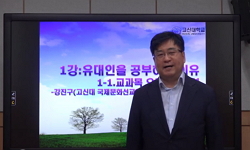In his work Dialogue of a Philosopher with a Jew, and with a Christian, Peter Abelard tries to understand the Christianity in discussion with its intellectual rivalries, i.e. with a Jew and with a Philosopher. It shows a new spirit that builds one of ...
http://chineseinput.net/에서 pinyin(병음)방식으로 중국어를 변환할 수 있습니다.
변환된 중국어를 복사하여 사용하시면 됩니다.
- 中文 을 입력하시려면 zhongwen을 입력하시고 space를누르시면됩니다.
- 北京 을 입력하시려면 beijing을 입력하시고 space를 누르시면 됩니다.

12세기 서방 라틴 그리스도교의 자기이해 - 아벨라르두스(1079~1142)의 <철학자와 유대인과 그리스도교인 간의 대화>를 중심으로 - = Understanding of Christianity in the 12th - Century Western Latin World: Dialogue of a Philosopher with a Jew, and with a Christian by Peter Abelard(1079~1142)
한글로보기https://www.riss.kr/link?id=A40103823
- 저자
- 발행기관
- 학술지명
- 권호사항
-
발행연도
2003
-
작성언어
-
-
주제어
아벨라르두스 ; Petrus Abaelardus ; 최고선 ; highest good ; summum bonum ; 그리스도교 ; Christianity ; 유대교 ; Judaism ; 이성 ; reason
-
KDC
900
-
등재정보
KCI등재
-
자료형태
학술저널
-
수록면
71-100(30쪽)
-
KCI 피인용횟수
0
- 제공처
- 소장기관
-
0
상세조회 -
0
다운로드
부가정보
다국어 초록 (Multilingual Abstract)
In his work Dialogue of a Philosopher with a Jew, and with a Christian, Peter Abelard tries to understand the Christianity in discussion with its intellectual rivalries, i.e. with a Jew and with a Philosopher. It shows a new spirit that builds one of the dominant axes of 12th-century self-understanding of the Christianity. The philosophical program of fides quaerens intellectum (faith seeking understanding) gives the contour of the whole dialogue; the Philosopher in this work wants to know, among the three modes of life, i.e. that of Christian, Judaic, and Philosophical, which is most consonant with reason. Through the discussion between the Jew and the Philosopher, a contrast between the historical peculiarity of the Old Law and the universality of Natural Law, which consists in loving God and one`s neighbor, becomes manifest. This claim of universality leads to the critic that it is not the external observance (opera exteriors) of the Old Law such as circumcision and purification rituals, but the inwardness based on human liberty that constitutes the morality. If inner love of God makes people holy, so runs the critic, the rituals of purification from sin as prescribed by the law can be of no spiritual value. Since the Philosopher admits the principally rational character of the Christianity, the main subject of their discussion is the Highest Good (summum bonum) and how to reach it. Once the happiness in the afterlife as the Highest Good is accepted, the Philosopher is compelled to confess the internal incoherence of classical virtue ethics. Then, the Christian has to reply to all the philosophical questions such as how is the vision of God to understand, whether heaven is in any place , and so on. The answers to these questions can be regarded as philosophical justification of the Christian Faiths, which culminates in the theodicy. The semantical analysis of good (bonum) supports the theological claim that God s omnipotence should include the good use of evil. It is one thing to say that Evil is good (malum est bonum) and another thing to say that It is good that there is evil (bonum est malum esse). According to Abelard, the Natural Law (lex naturalis) of a philosopher should be completed with the New Law (lex nova) of a Christian. This leads to the claim that the Christianity consists in the rationality (fides quaerens intellectum) and the inwardness (intentio) of the faith. It is this unique combination of the rationality and the inwardness of the Christian faith that characterizes the self-understanding of the 12th-century Christianity in the work of Dialogue of a Philosopher with a Jew, and with a Christian
동일학술지(권/호) 다른 논문
-
- 한국서양중세사학회
- 김동순 ( Kim Dong Sun )
- 2003
- KCI등재
-
- 한국서양중세사학회
- 김차규 ( Kim Cha Gyu )
- 2003
- KCI등재
-
- 한국서양중세사학회
- 박용진 ( Park Yong Jin )
- 2003
- KCI등재
-
- 한국서양중세사학회
- 김평중 ( Kim Pyeong Jung )
- 2003
- KCI등재
분석정보
인용정보 인용지수 설명보기
학술지 이력
| 연월일 | 이력구분 | 이력상세 | 등재구분 |
|---|---|---|---|
| 2026 | 평가예정 | 재인증평가 신청대상 (재인증) | |
| 2020-01-01 | 평가 | 등재학술지 유지 (재인증) |  |
| 2017-01-01 | 평가 | 등재학술지 유지 (계속평가) |  |
| 2013-01-01 | 평가 | 등재학술지 유지 (등재유지) |  |
| 2010-01-01 | 평가 | 등재학술지 유지 (등재유지) |  |
| 2007-01-01 | 평가 | 등재학술지 선정 (등재후보2차) |  |
| 2006-01-01 | 평가 | 등재후보 1차 PASS (등재후보1차) |  |
| 2004-01-01 | 평가 | 등재후보학술지 선정 (신규평가) |  |
학술지 인용정보
| 기준연도 | WOS-KCI 통합IF(2년) | KCIF(2년) | KCIF(3년) |
|---|---|---|---|
| 2016 | 0.21 | 0.21 | 0.23 |
| KCIF(4년) | KCIF(5년) | 중심성지수(3년) | 즉시성지수 |
| 0.25 | 0.21 | 0.807 | 0.08 |




 eArticle
eArticle







